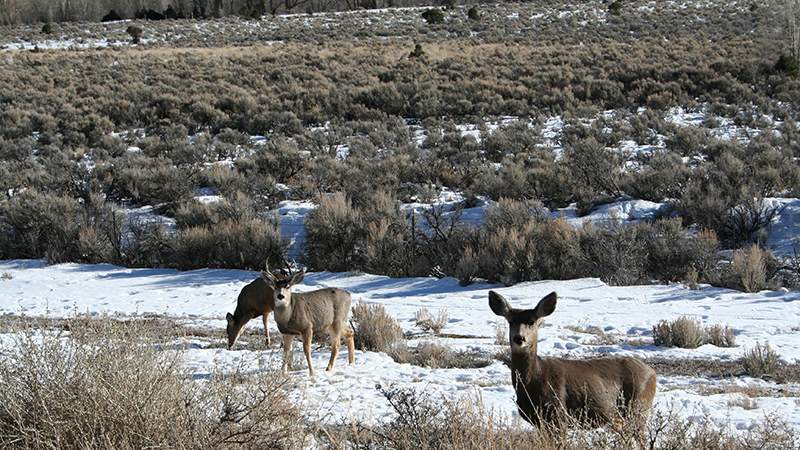Community Voices: The Joys and Difficulties of Rural Life
Leer en español
Deer grazing near a highway in Mogote. Photo by Pauline Victoria Martinez
By Pauline Victoria Martinez
The Colorado Trust has teamed with rural community members across Colorado who are helping facilitate conversations with neighbors about what they love about their communities, and what’s difficult about them. Pauline Victoria Martinez lives in Guadalupe, a community in Conejos County near the town of Antonito, and writes here about what people are talking about in the San Luis Valley.
In the rural San Luis Valley in southern Colorado, the rich culture and diverse ethnicities, long-held traditions, local cuisine, land, water and resources are just a few of the factors that contribute to people’s overall well-being.
There are many commonalities that can be found from one rural area to another. For example, many residents in the San Luis Valley express their love of the mountains, rivers, lakes, fishing, hiking and the many other outdoor recreational activities afforded them. They also enjoy the tight-knit communities they live in, with very little traffic. Many rural regions like this one have vast agricultural resources.
Perhaps surprising to some, however, are the vast differences that exist in these rural areas. Stereotyping can come easily. It is simple for outside organizations, cities and governments to dismiss issues in this area as “typical rural struggles.” Yet local residents and organizations know that the story is much more complicated.
On the east side of this valley is Costilla County, vast in land but sparse in population. Almost all of the land in this county—99 percent of it—is privately owned, according to county data. This gives the county a decent tax base, and 48 percent of tax dollars go to schools. On the other hand, it presents a problem for accessing recreational space and establishing parks, playgrounds and green spaces.
Shirley Romero Otero, a resident of San Luis, says that the lack of open and public spaces “is a deterrent of good health in Costilla County.”
A short distance away is Conejos County, the southern gateway to the San Luis Valley. Here, a majority of the land is owned by the Bureau of Land Management. This provides vast opportunities for wildlife areas, parks and outdoor recreation. However, it leaves a small tax base for the local schools, contributing to teacher turnover.
Farther west is Saguache, a historic town that serves as the northern gateway to the San Luis Valley. The isolated location of this town makes access to health care difficult. The nearest hospital, Rio Grande Hospital in Del Norte, is 37 miles away. However, some residents choose to travel to San Luis Valley Health in Alamosa, 52 miles away. A Salida-based family doctor comes to town once or twice a week. Residents say that the lack of public transportation exacerbates these issues.
These are only a few examples of the many differences that exist in rural communities—even in communities that are located near each other, in the same valley. These differences matter locally, as well as to outside organizations and governments. What works in one area may not work in another. What’s needed in one area may not be a priority in another. According to Community Heart and Soul, an organization serving rural communities, a cookie-cutter plan won’t work in rural America. A development plan that incorporates the community’s unique values and priorities is more likely to be sustainable.
Early needs assessments conducted by The Colorado Trust of over 300 residents in this area reveal some of the stories of struggles that exist. There is a loss of the younger generation due to migration toward the cities as they seek employment. There is also a lack of public transportation, which makes it difficult to access health care and sources of nutritious foods. The rapid turnover of health care providers is a major source of frustration and confusion for residents.
“Doctors come here and leave,” says Leo Armenta, a life-long resident in Conejos County. “Why can’t we have a full-time person?”
Yet these assessments have also illustrated what’s good about living in rural southern Colorado. During various community gatherings, residents across the San Luis Valley shared common joys about rural life. These reveal their reasons for remaining in rural areas and the source of passion residents have for wanting to better their communities. Here are some of the comments we heard:
“The community comes together in times of crisis.”
“It’s a peaceful, quiet town, where you know everybody.”
“Our strength is in our rich history and culture.”
“We’re a family, [and we] treat each other with love and respect.”
“It’s a safe place.”